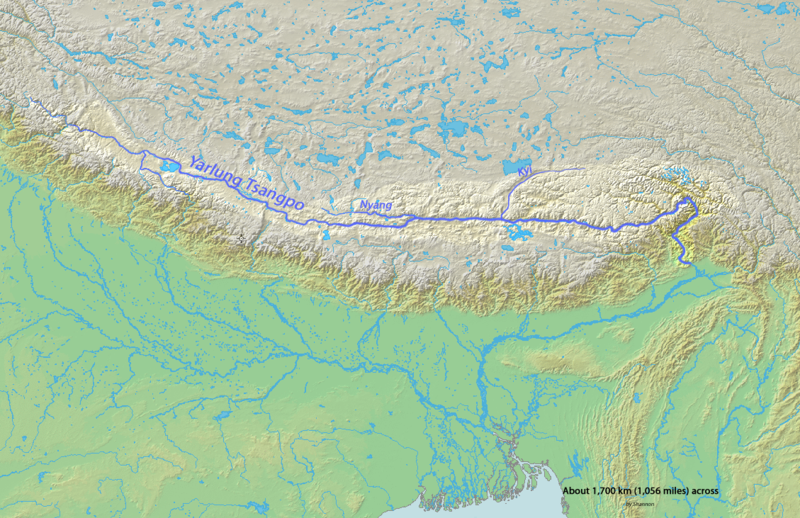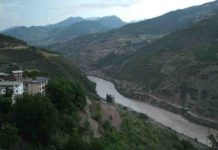
The Yarlung Tsangpo is the part of Brahmaputra River that flows through Tibet, known by its Tibetan name. It originates at Angsi Glacier in western Tibet southeast of Mount Kailash and Lake Manasarovar. It later forms the South Tibet Valley and Yarlung Tsangpo Grand Canyon before passing through the state of Arunachal Pradesh, India, where it is known as Siang.It is sometimes called Yarlung Zangbo or Yarlung Zangbo Jiang . The part Tsangpo denotes a river flowing from or through Tsang, meaning Tibet west of Lhasa.
Downstream from Arunachal Pradesh the river becomes wider and at this point is called the Siang. After reaching Assam, the river is known as Brahmaputra. From Assam, the river enters Bangladesh at Ramnabazar. From there until about 200 years ago it used to flow eastward and joined the Meghna River near Bhairab Upazila. This old channel has been gradually dying now. At present the main channel of the river is called Jamuna River, which flows southward to meet Ganges, which in Bangladesh is called the Padma.
When leaving the Tibetan Plateau, the Yarlung River flows in the world’s largest and deepest canyon, Yarlung Tsangpo Grand Canyon. The gorge has been described as “the highest river in the world” by the organizers of a kayaking expedition, although it’s not clear from their press release what definition was used.
Description
The Yarlung Tsangpo River is the highest major river in the world. Its longest tributary is the Nyang River. In Tibet the river flows through the South Tibet Valley, which is approximately 1,200 kilometres (750 mi) long and 300 kilometres (190 mi) wide. The valley descends from 4,500 metres (14,800 ft) above sea level to 3,000 metres (9,800 ft). As it descends, the surrounding vegetation changes from cold desert to arid steppe to deciduous scrub vegetation. It ultimately changes into a conifer and rhododendron forest. The tree line is approximately 3,200 metres (10,500 ft).Sedimentary sandstone rocks found near the Tibetan capital of Lhasa contain grains of magnetic minerals that record the Earth’s alternating magnetic field current.
The basin of the Yarlung River, bounded by the Himalayas in the south and Kang Rinpoche and Nyenchen Tanglha Mountains in the north, has less severe climate than the more northern (and higher-elevation) parts of Tibet, and is home to most of the Autonomous Region’s population (Lhasa City, Shigatse, Lhoka, and Nyingchi Prefectures).
The Yarlung Tsangpo Grand Canyon, formed by a horse-shoe bend in the river where it leaves the Tibetan Plateau and flows around Namcha Barwa, is the deepest, and possibly longest canyon in the world. The river has been a challenge to whitewater kayakers because of the extreme conditions of the river.
The Yarlung Tsangpo River has three major waterfalls. The largest waterfall of the river, the “Hidden Falls”, was not publicized in the West until 1998, when its sighting by Westerners was briefly hailed as a “discovery.” They were even portrayed as the discovery of the great falls which had been the topic of stories told to early Westerners by Tibetan hunters and Buddhist monks, but which had never been found by Western explorers at the time. Chinese authorities protested, however, saying that Chinese geographers, who had explored the gorge since 1973, had already taken pictures of the falls in 1987 from a helicopter.
Note : The above story is based on materials provided by Wikipedia










